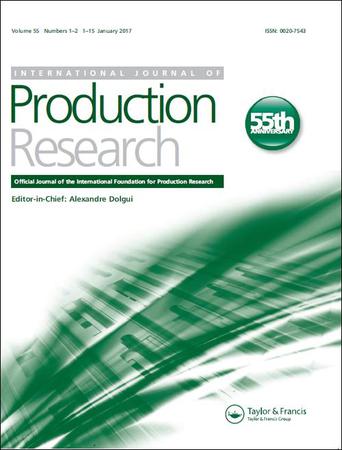Load prediction of parcel pick-up points: model-driven vs data-driven approaches
IF 7.3
2区 工程技术
Q1 ENGINEERING, INDUSTRIAL
International Journal of Production Research
Pub Date : 2023-09-16
DOI:10.1080/00207543.2023.2253475
引用次数: 0
Abstract
ABSTRACTPick-Up Points (PUPs) represent an alternative delivery option for online purchases. Parcels are delivered at a reduced cost to PUPs and wait until being picked up by customers or returned to the original warehouse if their sojourn time is over. When the chosen PUP is overloaded, the parcel may be refused and delivered to the next available PUP on the carrier tour. This paper presents and compares forecasting approaches for the load of a PUP to help PUP management companies balance delivery flows and reduce PUP overload. The parcel life-cycle has been taken into account in the forecasting process via models of the flow of parcel orders, the parcel delivery delays, and the pick-up process. Model-driven and data-driven approaches are compared in terms of load-prediction accuracy. For the considered example, the best approach (which makes use of the relationship of the load with the delivery and pick-up processes) is able to predict the load up to 4 days ahead with mean absolute errors ranging from 3.16 parcels (1 day ahead) to 8.51 parcels (4 days ahead) for a PUP with an average load of 45 parcels.KEYWORDS: Count time seriesload predictionparcel deliveryparcel pick-uppick-up point management AcknowledgmentsWe thank Professor Valdério Anselmo Reisen for his valuable comments.Data Availability StatementThe data that support the findings of this study are openly available in Github at https://github.com/cabani/ForecastingParcels.Disclosure statementNo potential conflict of interest was reported by the author(s).Notes1 Based on the statistical analysis in Appendix A, 80 % of the parcels are picked up two days after their delivery, and only 1 % are still in the PUP six days after their delivery. The considered simplifying assumption about smax only marginally impacts the load prediction results.Additional informationNotes on contributorsThi-Thu-Tam NguyenTam Nguyen received her PhD degree in Computer Science from Paris Saclay University, Orsay, France in 2023. Her research interests include statistical and machine learning based models applied to time series analysis and forecasting.Adnane CabaniAdnane Cabani received his Ph.D. degree in Computer Science from INSA Rouen Normandie in December 2007. He obtained his HDR, French Accreditation to Direct Research, in March 2021 from University of Rouen Normandy. He is a Professor of Computer Science at ESIGELEC/IRSEEM. Currently, he is the head of the Software Engineering & Digital Transformation Master's programme and a member of the steering committee of the federative structure in logistics SFLog FED 4230. He has co-authored 70 research papers, conference proceedings, books, and standards in the areas of Intelligent Transport Systems and Logistics.Iyadh CabaniIyadh Cabani received his Ph.D. degree in Computer Science from INSA Rouen Normandie in 2007. He obtained the Executive Certificate, BigData for Digital Business from CentraleSupelec in 2022. He has been a reviewer for several years in IEEE conferences and journals in the field of image processing. In addition, he held the positions of Chief Data Officer and Data Protection Officer within the Pickup Group (a subsidiary of La Poste Group). He is now Chief Executive Officer of uUsUu SAS specialising in the field of consulting on the themes of complex program management, data-centric information systems, and artificial intelligence.Koen De TurckKoen De Turck is an associate professor at the TELIN department of the Faculty of Engineering and Architecture at Ghent University since October 2021. From 2015 to 2021, he was an associate professor (MCF) at the Telecommunications Department of CentraleSupélec and a researcher at the Laboratoire des Signaux et Systémes, Gif-sur-Yvette. His research interests include stochastic modelling of telecommunication systems, queueing theory, scaling methods, and asymptotic analysis. These techniques are applied to a number of domains, notably including wireless networks, and in particular, energy efficiency and bandwidth reutilisation. He is also interested random graph methods, stochastic learning and designing efficient simulation algorithms.Michel KiefferMichel Kieffer is a full professor in signal processing for communications at Université Paris-Saclay and a researcher at the Laboratoire des Signaux et Systémes, Gif-sur-Yvette. His research interests are in signal processing for multimedia, communications, and networking, distributed source coding, network coding, joint source-channel coding and decoding, joint source-network coding. Michel Kieffer is co-author of more than 200 contributions in journals and in conference proceedings. He filed 12 patents and is co-author of 2 books: Applied Interval Analysis published by Springer-Verlag in 2001, and Joint source-channel decoding: A cross layer perspective with applications in video broadcasting published by Academic Press in 2009. He serves as associate editor of Signal Processing since 2008 and of the IEEE Transactions on Communications from 2012 to 2016. From 2011 to 2016, Michel Kieffer was a junior member of the Institut Universitaire de France.包裹取件点的负载预测:模型驱动vs数据驱动的方法
摘要取货点(pup)代表了在线购买的另一种交付选择。包裹以较低的成本交付给幼崽,等待客户取货,或者在停留时间结束后返回原仓库。当选择的PUP超载时,包裹可能会被拒绝并交付给承运人巡回的下一个可用的PUP。本文提出并比较了PUP负荷的预测方法,以帮助PUP管理公司平衡交付流并减少PUP过载。通过包裹订单流、包裹交付延迟和取件过程的模型,在预测过程中考虑了包裹生命周期。比较了模型驱动和数据驱动两种方法的负荷预测精度。对于所考虑的示例,最佳方法(利用负载与交付和提取过程之间的关系)能够提前4天预测负载,平均绝对误差范围从3.16个包裹(提前1天)到8.51个包裹(提前4天),平均负载为45个包裹。关键词:计数,时间序列,负荷预测,包裹投递,包裹取件点管理,感谢valdsamio Anselmo Reisen教授的宝贵意见。数据可用性声明支持本研究结果的数据可在Github上公开获取https://github.com/cabani/ForecastingParcels.Disclosure声明作者未报告潜在的利益冲突。注1根据附录A的统计分析,80%的包裹在投递2天后被取走,只有1%的包裹在投递6天后仍在PUP中。所考虑的关于smax的简化假设对负荷预测结果的影响很小。thi - thu - tam Nguyen Nguyen于2023年在法国奥赛的巴黎萨克莱大学获得计算机科学博士学位。她的研究兴趣包括应用于时间序列分析和预测的基于统计和机器学习的模型。Adnane Cabani于2007年12月获得INSA Rouen Normandie计算机科学博士学位。他于2021年3月从诺曼底鲁昂大学(University of Rouen Normandy)获得了法国直接研究认证。他是ESIGELEC/IRSEEM的计算机科学教授。目前,他是软件工程与数字化转型硕士课程的负责人,也是物流联邦结构SFLog FED 4230指导委员会的成员。他在智能交通系统和物流领域共同撰写了70篇研究论文、会议记录、书籍和标准。Iyadh Cabani于2007年获得INSA Rouen Normandie计算机科学博士学位。他于2022年获得CentraleSupelec的数字业务大数据执行证书。多年来,他一直是图像处理领域的IEEE会议和期刊的审稿人。此外,他曾担任the Pickup Group (La Poste Group的子公司)的首席数据官和数据保护官。他现在是uUsUu SAS的首席执行官,专门从事复杂项目管理、以数据为中心的信息系统和人工智能等主题的咨询领域。Koen De Turck自2021年10月起担任根特大学工程与建筑学院TELIN系副教授。2015年至2021年,他在centralesupacress电信系担任副教授,在Gif-sur-Yvette的信号与系统实验室担任研究员。他的研究兴趣包括电信系统的随机建模、排队理论、标度方法和渐近分析。这些技术应用于许多领域,特别是包括无线网络,特别是能源效率和带宽再利用。他还对随机图方法,随机学习和设计有效的仿真算法感兴趣。米歇尔·基弗(Michel Kieffer)是巴黎萨克雷大学通信信号处理专业的正教授,也是伊维特省吉夫河畔信号与系统实验室的研究员。主要研究方向为多媒体、通信、网络信号处理、分布式信源编码、网络编码、信信道联合编码与解码、信网络联合编码。米歇尔·基弗(Michel Kieffer)在期刊和会议论文集上发表了200多篇论文。他申请了12项专利,并与人合著了两本书:2001年由施普林格出版社出版的《应用区间分析》和2009年由学术出版社出版的《联合源信道解码:视频广播应用的跨层视角》。 他自2008年起担任信号处理副主编,2012年至2016年担任IEEE通信交易副主编。2011年至2016年,米歇尔·基弗(Michel Kieffer)是法国大学研究所(Institut Universitaire de France)的初级成员。
本文章由计算机程序翻译,如有差异,请以英文原文为准。
求助全文
约1分钟内获得全文
求助全文
来源期刊

International Journal of Production Research
管理科学-工程:工业
CiteScore
19.20
自引率
14.10%
发文量
318
审稿时长
6.3 months
期刊介绍:
The International Journal of Production Research (IJPR), published since 1961, is a well-established, highly successful and leading journal reporting manufacturing, production and operations management research.
IJPR is published 24 times a year and includes papers on innovation management, design of products, manufacturing processes, production and logistics systems. Production economics, the essential behaviour of production resources and systems as well as the complex decision problems that arise in design, management and control of production and logistics systems are considered.
IJPR is a journal for researchers and professors in mechanical engineering, industrial and systems engineering, operations research and management science, and business. It is also an informative reference for industrial managers looking to improve the efficiency and effectiveness of their production systems.
 求助内容:
求助内容: 应助结果提醒方式:
应助结果提醒方式:


